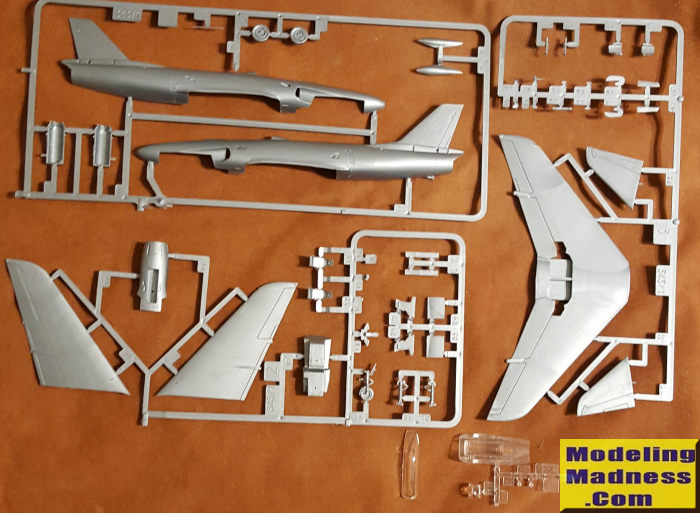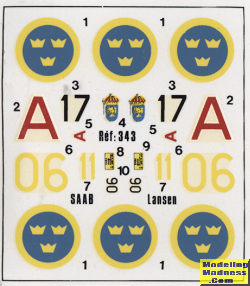
Heller 1/72 Saab J.32 Lansen
| KIT #: | 343 |
| PRICE: | $9.95 when new in 1983 |
| DECALS: | Two options |
| REVIEWER: | Scott Van Aken |
| NOTES: | 1982 initial tooling |

| HISTORY |
The Saab 32 Lansen (meaningthe Lance) was a two-seat, high transsonic attack aircraft produced by SAAB from 1955 to 1960 for the Swedish Air Force (Flygvapnet). During its long operational life, the Saab 32 also served as a fighter, reconnaissance, electronic warfare and a target-tug aircraft.
When the A 32A entered service they replaced the last piston-powered SAAB B 18 bomber. Soon after entering squadron service, the J 32 Lansen broke the sound barrier on 25 October 1953 when a production aircraft exceeded Mach 1 in a shallow dive. The J 32 carried four 30 mm ADEN cannons while the A 32 ("A" stands for attack) had an armament of four 20 mm Bofors m/49 cannon hidden under flaps in the nose and the Rb 04C anti-ship missile, one of the earliest of its type in western service. The Lansen normally was fitted with two missiles but it could also carry an additional missile. Its main role was to prevent any Soviet invasion across Sweden's extensive coastline.
One planned use of the A 32A was to deliver nuclear warheads or chemical weapons. Sweden had an active nuclear weapons program during the 1950s and 1960s, but no weapons were ever produced.
The A 32 Lansen was Sweden's last purpose-built attack aircraft. Throughout the Cold War years, the Lansen distinguished itself with a solid if unspectacular career; Swedish pilots often described it as pleasant to fly. Gradually being replaced by more modern types, the Saab 32 soldiered on into the late 1990s. Two still remain operational with the sole task of taking high altitude air samples for research purposes in collaboration with the Swedish Radiation Safety Authority. One of those has been used to collect volcanic ash samples in April and May 2010.
| THE KIT |
 Typical
of Heller kits of the day, this one has raised external detailing, though it is
very well done. The cockpit consists of the tub, two seats, a pilot's control
stick and two instrument panels, though mine is missing one of them, which is
odd as the kit was sealed when I bought it and still sealed when I opened it for
this article.
Typical
of Heller kits of the day, this one has raised external detailing, though it is
very well done. The cockpit consists of the tub, two seats, a pilot's control
stick and two instrument panels, though mine is missing one of them, which is
odd as the kit was sealed when I bought it and still sealed when I opened it for
this article.
Before joining the fuselage halves, an exhaust section has to be assembled and installed as well as small extension pieces for the intakes. The kit has two lower nose sections. One is for the fighter/attack version and the other is clear plastic for the recce plane. If doing the recce plane, bulges need to be added to the upper fuselage for camera clearance. These lower inserts incorporate the nose gear well. Weight is needed, but no amount is indicated.
Wings are single lower with upper halves. The gear wells are not boxed in. Wing fences are separate items. Before adding the one piece canopy, a few other bits need to be added to the cockpit. Note that the Lansen has radio antennas on the upper inner wing. Landing gear is nicely done with the nose gear leg incorporating the nose wheel. There are landing lights that fit into both nose gear doors.
 Instructions
have seven construction steps and are nicely drawn. Two options are provided on
the smallish decal sheet. One is an A.32A as shown on the box art. The recce
bird is an olive green upper with a blue-grey underside. Though old, my decals
seemed to be in fairly good condition. Note that Heller decals of this era were
fairly thick compared to today's offerings.
Instructions
have seven construction steps and are nicely drawn. Two options are provided on
the smallish decal sheet. One is an A.32A as shown on the box art. The recce
bird is an olive green upper with a blue-grey underside. Though old, my decals
seemed to be in fairly good condition. Note that Heller decals of this era were
fairly thick compared to today's offerings.
| CONCLUSIONS |
Apparently this kit sells rather well. Heller ha most recently reissued it in 2020 and did so only two years previous to that. What is missing from the kit is the fairly large belly fuel tank that was carried much of the time, but there are aftermarket options for this. So far, this is the only kit of this aircraft in this scale.
November 2021 Copyright ModelingMadness.com.
All rights reserved. No reproduction in part or in whole without express
permission. If you would like your product reviewed fairly and
fairly quickly, please
contact
the editor or see other details in the
Note to
Contributors.